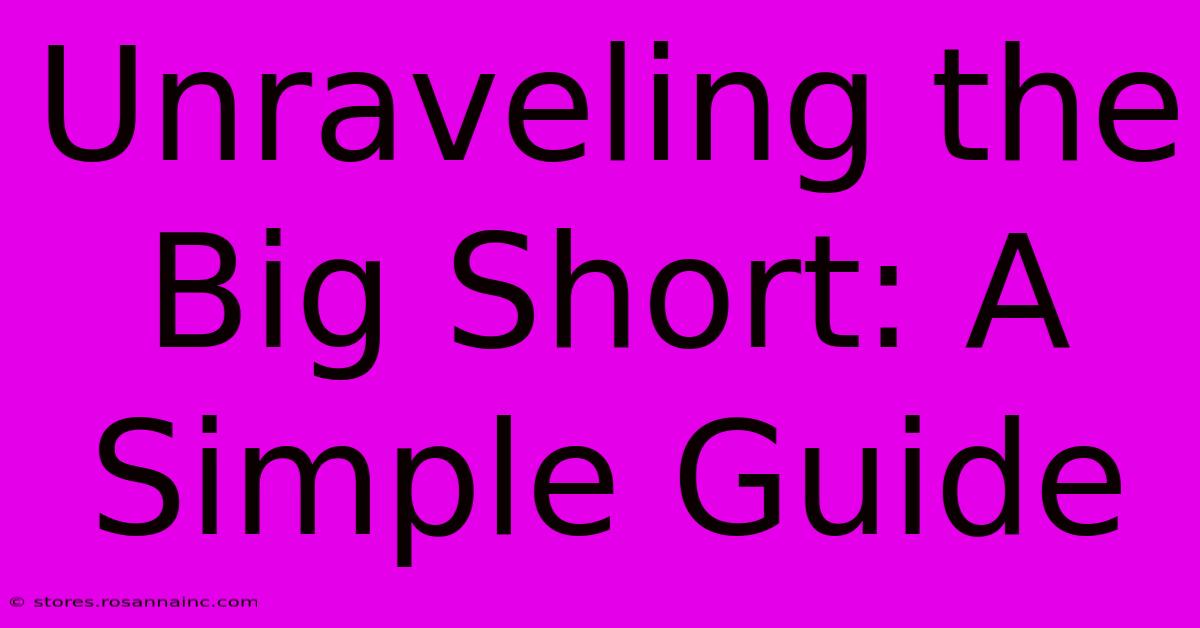Unraveling The Big Short: A Simple Guide

Table of Contents
Unraveling the Big Short: A Simple Guide
The "Big Short," a term referring to the massive bet against the US housing market before its 2008 collapse, might sound complex. But understanding the core principles behind it doesn't require a PhD in finance. This guide will break down the key elements, making this crucial moment in economic history accessible to everyone.
Understanding the Housing Bubble
The foundation of the Big Short lies in the housing bubble. For years leading up to 2008, housing prices were skyrocketing. This wasn't driven by organic market forces; instead, it was fueled by several factors:
- Easy Credit: Banks were readily providing mortgages to people with poor credit scores – subprime mortgages. These loans often came with adjustable interest rates, meaning payments could dramatically increase later.
- Securitization: Mortgages were bundled together into complex financial products called mortgage-backed securities (MBS) and collateralized debt obligations (CDOs). This made them seem safer than they actually were, spreading the risk across numerous investors.
- Rating Agencies: Credit rating agencies gave many of these MBS and CDOs high ratings, misleading investors about their true risk.
Essentially, the system was built on a house of cards. As long as house prices kept rising, everything seemed fine. But what happened when prices stopped rising?
The Big Short: Betting Against the System
A small group of investors, including Michael Burry, Steve Eisman, and Greg Lippmann (famously portrayed in the movie The Big Short), recognized the inherent flaws in the system. They saw that:
- Subprime mortgages were risky: Many borrowers wouldn't be able to keep up with payments once interest rates adjusted.
- The MBS and CDOs were opaque: The complexity of these securities made it difficult to assess their true value and risk.
- The market was overvalued: Housing prices were unsustainable and destined for a correction.
These investors used various financial instruments, including credit default swaps (CDS), to essentially bet against the housing market. A CDS is like an insurance policy: if the MBS or CDO defaults (fails to pay), the investor who bought the CDS receives a payout. They were essentially betting that the housing market would crash.
The Aftermath: The 2008 Financial Crisis
As predicted, the housing bubble burst. Subprime mortgages started to default in large numbers, causing the value of MBS and CDOs to plummet. This triggered a chain reaction, leading to the 2008 financial crisis. Banks suffered massive losses, credit markets froze, and the global economy spiraled into recession.
The Big Short investors, who had correctly anticipated this collapse, made enormous profits. However, their success came at a tremendous cost to the global economy and millions of individuals who lost their homes and savings.
Lessons from the Big Short
The Big Short serves as a cautionary tale, highlighting the dangers of:
- Excessive risk-taking: The pursuit of short-term profits often leads to long-term consequences.
- Lack of transparency: Opaque financial instruments and inadequate regulation can mask significant risks.
- Overreliance on credit ratings: Rating agencies are not infallible, and their ratings should be critically examined.
Understanding the Big Short is crucial for navigating the complexities of the financial world and appreciating the importance of responsible lending, regulation, and risk management. It’s a story about flawed systems, brilliant foresight, and the devastating consequences of unchecked greed. While the details might be intricate, the core lesson is simple: sometimes, the biggest risks are hidden in plain sight.

Thank you for visiting our website wich cover about Unraveling The Big Short: A Simple Guide. We hope the information provided has been useful to you. Feel free to contact us if you have any questions or need further assistance. See you next time and dont miss to bookmark.
Featured Posts
-
Roseland New Jersey Find Your Perfect Escape
Feb 10, 2025
-
Is Your Brick And Mortar Business Future Proof
Feb 10, 2025
-
What If The Ugliest Person Held The Key To Confidence
Feb 10, 2025
-
Kendrick Lamar Super Bowl Lvii
Feb 10, 2025
-
Paralympic Wheelchair Basketball A Story Of Resilience And Triumph
Feb 10, 2025
